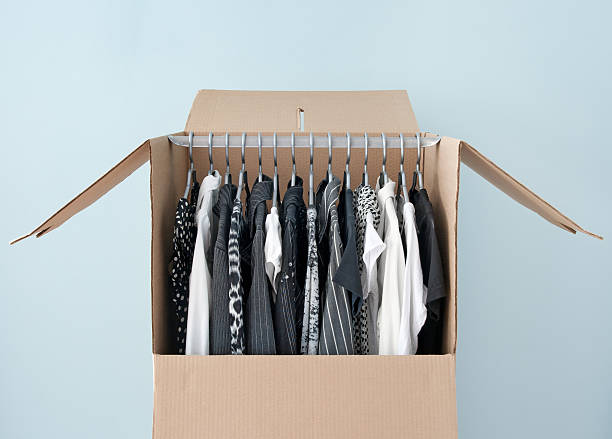Packing up your clothes its an essential part of the moving process. It’s also one of the more stress-free tasks of the packing process. Because clothing items are generally seasonal, it’s actually pretty simple to stay organized with your belongings and pack as you go. Often, our clothes and shoes can be some of our most prized possessions, which means that it is crucial to preserve their quality during the move. While some packing tips may be somewhat obvious, we’ve put together a thorough guide for you to help you pack your clothes for moving.
HOW TO PACK CLOTHES FOR MOVING
Packing clothes for your move is all about staying organized. It is crucial to identify and categorize your clothing based on season and function. If you are planning a summer move, you should start packing away your winter items first. That way, you won’t pack away anything you’ll need in the short term. Because winter items are generally on the bulkier side, we recommend using vacuum sealed packs to save room.
Once you’ve got your off-season clothes out of the way, you can start packing other clothes you may need. But, as you get closer to your moving date, you’ll want to only have the clothes you need immediately on hand. You’ll want to keep a few changes of clothes on hand, as well as your “moving clothes” for moving day. Try to wear something comfortable that you can move around in.
THINGS TO DO BEFORE PACKING YOUR CLOTHES
Before you get packing, try to acquire some good organizational containers. Because clothing is generally not fragile, you can get away with packing in clothing in just about anything. Keep garment bags from purchases you make, and other containers like shoeboxes for more organized packing.
When packing up your belongings it’s important to declutter and downsize. Look through all of your clothing, outerwear and shoes to see what you want to keep and what you can donate. If you are not prepared to donate, you can look into placing some items in storage.
Downsizing your belongings can help make the move so much easier. You can also make a bit of cash if you have some items in good condition that you can sell.
Next, we would recommend that you wash your clothing since you’ll likely be keeping them in boxes for some time. It would be a shame for your clothes to get stinky because you forgot to wash them.
HOW TO PACK NON-HANGING CLOTHES
Non-hanging clothes like t-shirts, leggings, sweaters, sweatshirts can be packed in duffel bags, plastic bags, tote bags, suitcases, drawstring trash bags and vacuum-sealed bags. Any other clothing that is not structured can be packed in both moving boxes or any other type of bag you can find. In fact, garbage bags can be a super cheap and effective packing strategy for non fragile items.
Other clothing that you tend to store in dresser drawers like socks, underwear and work out clothes can go into boxes or bags. Sometimes the best way to move clothes is to keep them in the dresser drawers and have professional movers tape the dressers shut so that nothing falls out during the move.
There are several ways to pack non-hanging clothes. You can either fold each item on top of one another, or you can use the roll-up method. You can also purchase packing cubes to help organize certain types of clothes and help keep them together.
When packing clothing, try to put heavier items at the bottom of the box. This is a key technique to avoid your belongings from getting smashed or damaged during the move. Another packing hack is to avoid overpacking your boxes. Though clothes seem to be light and malleable, when you overpack you can potentially end up breaking cardboard boxes. Sometimes, you may even want to double box your clothing to avoid any hiccups along the way.
HOW TO PACK HANGING CLOTHES
For clothes that need to be hung up, you may need to acquire some wardrobe boxes. Generally, this means jackets, blazers, gowns and other structured clothing that you would place on hangers. This will help preserve the quality of the clothing and avoid unnecessary wrinkles and damage. You can also plastic wrap over your clothes to help protect certain pieces from dust and other debris.
HOW TO PACK SHOES
Often, putting your shoes in a dust bag and the shoe box they came in can be the easiest strategy. You can also stack shoes in moving boxes depending on how delicate they are. Try to stuff them with newspaper or socks to help them keep their shape.
USE A PACKING SERVICE TO HELP YOU PACK YOUR CLOTHES FOR RELOCATING
If you are short on time, you can always hire a professional packing service to assist you with both packing and unpacking your belongings. Professional movers generally offer packing services along with supplying all necessary packing materials: moving boxes, packing tape, packing paper and so on.
A moving company can assist you through the entire process. From packing, to loading the moving truck, to unloading it all into your new house. We recommend you reach out to a moving company in your area and request a quote to see what this will cost.
MORE CLOTHES PACKING TIPS
Because most people tend to have more clothes than they know what to do with, we recommend packing in an organized fashion. When you label all of your boxes, you’ll have a far easier time unpacking when you arrive at your new home. Often, people don’t end up unpacking their clothes for months and even forget what they packed in the first place.
Another important packing tip is to consider using your clothes themselves as packing materials. For instance, you can use your t-shirts to pack fragile dishware and other knick knacks around your house.

